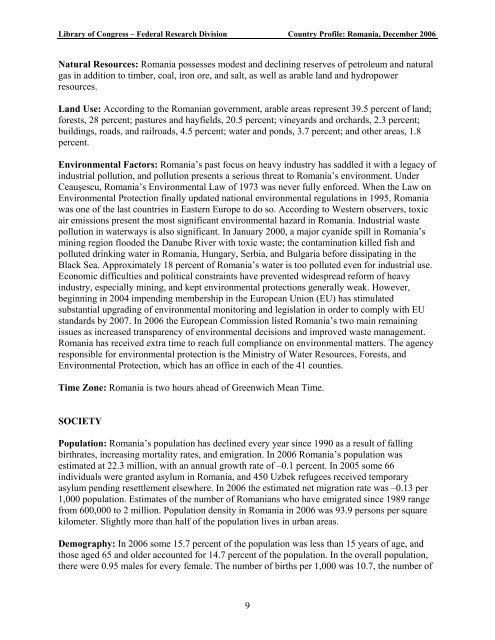Country Profile: Romania - Library of Congress
Country Profile: Romania - Library of Congress
Country Profile: Romania - Library of Congress
You also want an ePaper? Increase the reach of your titles
YUMPU automatically turns print PDFs into web optimized ePapers that Google loves.
<strong>Library</strong> <strong>of</strong> <strong>Congress</strong> – Federal Research Division <strong>Country</strong> <strong>Pr<strong>of</strong>ile</strong>: <strong>Romania</strong>, December 2006<br />
Natural Resources: <strong>Romania</strong> possesses modest and declining reserves <strong>of</strong> petroleum and natural<br />
gas in addition to timber, coal, iron ore, and salt, as well as arable land and hydropower<br />
resources.<br />
Land Use: According to the <strong>Romania</strong>n government, arable areas represent 39.5 percent <strong>of</strong> land;<br />
forests, 28 percent; pastures and hayfields, 20.5 percent; vineyards and orchards, 2.3 percent;<br />
buildings, roads, and railroads, 4.5 percent; water and ponds, 3.7 percent; and other areas, 1.8<br />
percent.<br />
Environmental Factors: <strong>Romania</strong>’s past focus on heavy industry has saddled it with a legacy <strong>of</strong><br />
industrial pollution, and pollution presents a serious threat to <strong>Romania</strong>’s environment. Under<br />
Ceauşescu, <strong>Romania</strong>’s Environmental Law <strong>of</strong> 1973 was never fully enforced. When the Law on<br />
Environmental Protection finally updated national environmental regulations in 1995, <strong>Romania</strong><br />
was one <strong>of</strong> the last countries in Eastern Europe to do so. According to Western observers, toxic<br />
air emissions present the most significant environmental hazard in <strong>Romania</strong>. Industrial waste<br />
pollution in waterways is also significant. In January 2000, a major cyanide spill in <strong>Romania</strong>’s<br />
mining region flooded the Danube River with toxic waste; the contamination killed fish and<br />
polluted drinking water in <strong>Romania</strong>, Hungary, Serbia, and Bulgaria before dissipating in the<br />
Black Sea. Approximately 18 percent <strong>of</strong> <strong>Romania</strong>’s water is too polluted even for industrial use.<br />
Economic difficulties and political constraints have prevented widespread reform <strong>of</strong> heavy<br />
industry, especially mining, and kept environmental protections generally weak. However,<br />
beginning in 2004 impending membership in the European Union (EU) has stimulated<br />
substantial upgrading <strong>of</strong> environmental monitoring and legislation in order to comply with EU<br />
standards by 2007. In 2006 the European Commission listed <strong>Romania</strong>’s two main remaining<br />
issues as increased transparency <strong>of</strong> environmental decisions and improved waste management.<br />
<strong>Romania</strong> has received extra time to reach full compliance on environmental matters. The agency<br />
responsible for environmental protection is the Ministry <strong>of</strong> Water Resources, Forests, and<br />
Environmental Protection, which has an <strong>of</strong>fice in each <strong>of</strong> the 41 counties.<br />
Time Zone: <strong>Romania</strong> is two hours ahead <strong>of</strong> Greenwich Mean Time.<br />
SOCIETY<br />
Population: <strong>Romania</strong>’s population has declined every year since 1990 as a result <strong>of</strong> falling<br />
birthrates, increasing mortality rates, and emigration. In 2006 <strong>Romania</strong>’s population was<br />
estimated at 22.3 million, with an annual growth rate <strong>of</strong> –0.1 percent. In 2005 some 66<br />
individuals were granted asylum in <strong>Romania</strong>, and 450 Uzbek refugees received temporary<br />
asylum pending resettlement elsewhere. In 2006 the estimated net migration rate was –0.13 per<br />
1,000 population. Estimates <strong>of</strong> the number <strong>of</strong> <strong>Romania</strong>ns who have emigrated since 1989 range<br />
from 600,000 to 2 million. Population density in <strong>Romania</strong> in 2006 was 93.9 persons per square<br />
kilometer. Slightly more than half <strong>of</strong> the population lives in urban areas.<br />
Demography: In 2006 some 15.7 percent <strong>of</strong> the population was less than 15 years <strong>of</strong> age, and<br />
those aged 65 and older accounted for 14.7 percent <strong>of</strong> the population. In the overall population,<br />
there were 0.95 males for every female. The number <strong>of</strong> births per 1,000 was 10.7, the number <strong>of</strong><br />
9

















